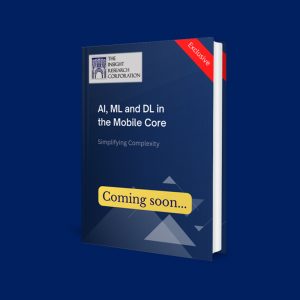1 Executive Summary
1.1 Key observations
1.2 Quantitative Forecast Taxonomy
1.3 Report Organization
2 AI/ML/DL – Key Concepts Explainer
2.1 Artificial Intelligence
2.2 Machine Learning (ML)
2.2.1 Supervised Machine Learning
2.2.2 Unsupervised Machine Learning
2.2.3 Reinforced Machine Learning
2.2.4 K-Nearest Neighbor
2.3 Deep Learning Neural Network (DLNN)
2.4 Noteworthy ML and DL Algorithms
2.4.1 Anomaly Detection
2.4.2 Artificial Neural Networks (ANN)
2.4.3 Bagged Trees
2.4.4 CART and SVM Algorithms
2.4.5 Clustering
2.4.6 Conditional Variational Autoencoder
2.4.7 Convolutional Neural Network
2.4.8 Correlation and Clustering
2.4.9 Evolutionary Algorithms and Distributed Learning
2.4.10 Feed Forward Neural Network
2.4.11 Graph Neural Networks
2.4.12 Hybrid Cognitive Engine (HCE)
2.4.13 Kalman Filter
2.4.14 Markov Decision Processes
2.4.15 Multilayer Perceptron
2.4.16 Naïve Bayes
2.4.17 Radial Basis Function
2.4.18 Random Forest
2.4.19 Recurrent Neural Network
2.4.20 Reinforced Neural Network
2.4.21 SOM Algorithm
2.4.22 Sparse Bayesian Learning
3 Virtualization of the RAN
3.1 The RAN and its Evolution
3.1.1 Closer Look at E-UTRAN
3.1.2 5G- NR, NSA and SA
3.1.3 MEC
3.1.4 The Rigid CPRI
3.2 The Progression of the RAN to the vRAN
3.3 How VM-based and Container-based vRANs Compare?
3.3.1 NFV architecture
3.3.2 The Need for Containers
3.3.3 Microservices
3.3.4 Container Morphology
3.3.5 Container Deployment Methodologies
3.3.6 Stateful and Stateless Containers
3.3.7 Advantage Containers
3.3.8 Challenges Confronting Containers
3.4 RAN Virtualization – A Story of Alliances
3.4.1 O-RAN Architecture Overview
3.4.2 History of O-RAN
3.4.3 Workgroups of O-RAN
3.4.4 Open vRAN (O-vRAN)
3.4.5 Telecom Infra Project (TIP) OpenRAN
4 End-applications for AI in the RAN
4.1 O-RAN and AI
4.1.1 Introduction
4.1.2 RIC, xApps and rApps
4.1.3 WG2 and ML
4.2 AI Use-Case – Traffic Optimization
4.2.1 Background
4.2.2 Methodologies and Challenges
4.2.3 AI-based Approaches
4.3 AI Use-Case – Caching
4.3.1 Background
4.3.2 Methodologies and Challenges
4.3.3 AI-based Approaches
4.4 AI Use-Case – Energy Management
4.4.1 Background
4.4.2 Methodologies and Challenges
4.4.3 AI-based Approaches
4.5 AI Use-Case – Coding
4.5.2 AI-based Approaches
5 Vendor Initiatives for AI in the RAN
5.1 Introduction
5.2 Salient Observations
5.3 Company and Organization Summary
5.4 Aira Channel Prediction xApp
5.5 Aira Dynamic Radio Network Management rApp
5.6 AirHop Auptim
5.7 Aspire Anomaly Detection rApp
5.8 Cisco Ultra Traffic Optimization
5.9 Capgemini RIC
5.1 Cohere MU-MIMO Scheduler
5.11 DeepSig OmniSig
5.12 Deepsig OmniPHY
5.13 Ericsson Radio System
5.14 Ericsson RIC
5.15 Fujitsu Open RAN Compliant RUs
5.16 HCL iDES rApp
5.17 Huawei PowerStar
5.18 Juniper RIC/Rakuten Symphony Symworld
5.19 Mavenir mMIMO 64TRX
5.20 Mavenir RIC
5.21 Net AI xUPscaler Traffic Predictor xApp
5.22 Nokia RAN Intelligent Controller
5.23 Nokia AVA
5.24 Nokia ReefShark Soc
5.25 Nvidia AI-on-5G platform
5.26 Opanga Networks
5.27 P.I. Works Intelligent PCI Collision and Confusion Detection rApp
5.28 Qualcomm RIC
5.29 Qualcomm Cellwize CHIME
5.30 Qualcomm Traffic Management Solutions
5.31 Rimedo Policy-controlled Traffic Steering xApp
5.32 Samsung Network Slice Manager
5.33 ZTE PowerPilot
5.34 VMware RIC
6 Telco Initiatives for AI in the RAN
6.1 Introduction
6.2 Salient Observations
6.3 Company and Organization Summary
6.4 AT&T Inc
6.5 Axiata Group Berhad
6.6 Bharti Airtel
6.7 China Mobile
6.8 China Telecom
6.9 China Unicom
6.10 CK Hutchison Holdings
6.11 Deutsche Telekom
6.12 Etisalat
6.13 Globe Telecom Inc
6.14 NTT DoCoMo
6.15 MTN Group
6.16 Ooredoo
6.17 Orange
6.18 PLDT Inc
6.19 Rakuten Mobile
6.20 Reliance Jio
6.21 Saudi Telecom Company
6.22 Singtel
6.23 SK Telecom
6.24 Softbank
6.25 Telefonica
6.26 Telenor
6.27 Telkomsel
6.28 T-Mobile US
6.29 Verizon
6.30 Viettel Group
6.31 Vodafone
7 Quantitative Analysis and Forecasts
7.1 Research Methodology
7.2 Forecast Taxonomy
7.3 Global Market
7.3.1 Overall Market
7.3.2 Mobile Telephony Generations
7.3.3 Geographical Regions
7.4 Traffic Optimization
7.4.1 Overall Market
7.4.2 Mobile Telephony Generations
7.4.3 Geographical Regions
7.5 Caching
7.5.1 Overall Market
7.5.2 Mobile Telephony Generations
7.5.3 Geographical Regions
7.6 Energy Management
7.6.1 Overall Market
7.6.2 Mobile Telephony Generations
7.6.3 Geographical Regions
7.7 Coding
7.7.1 Overall Market
7.7.2 Mobile Telephony Generations
7.7.3 Geographical Regions




